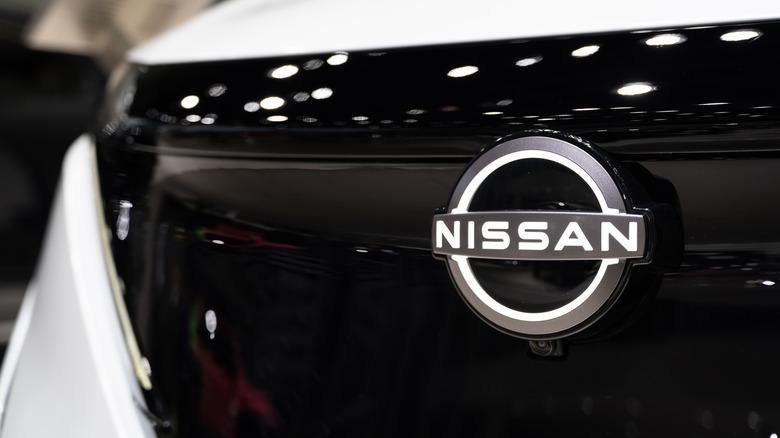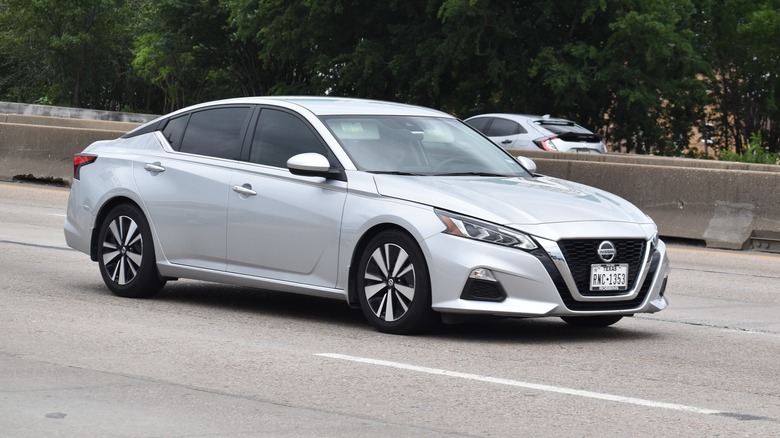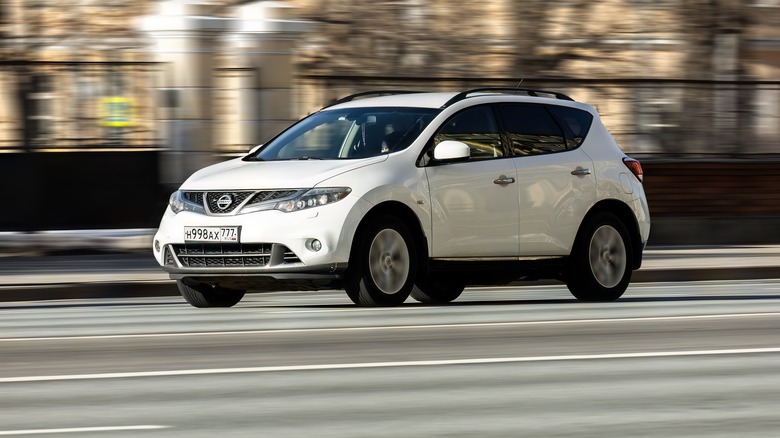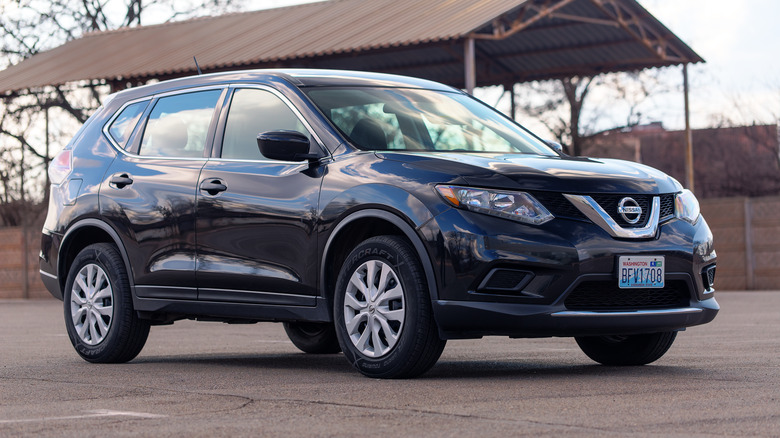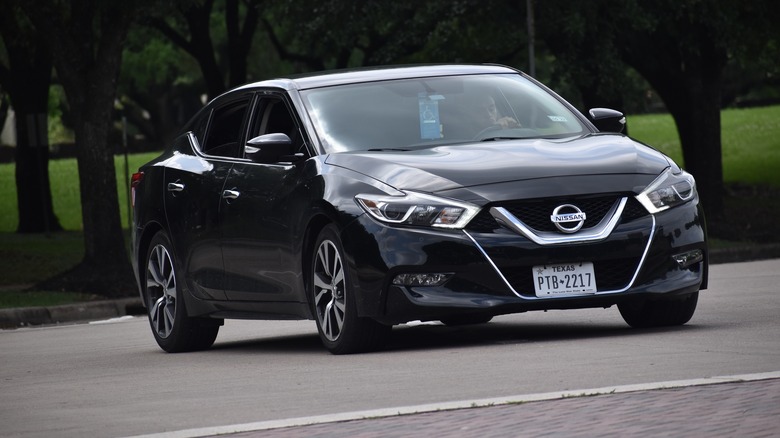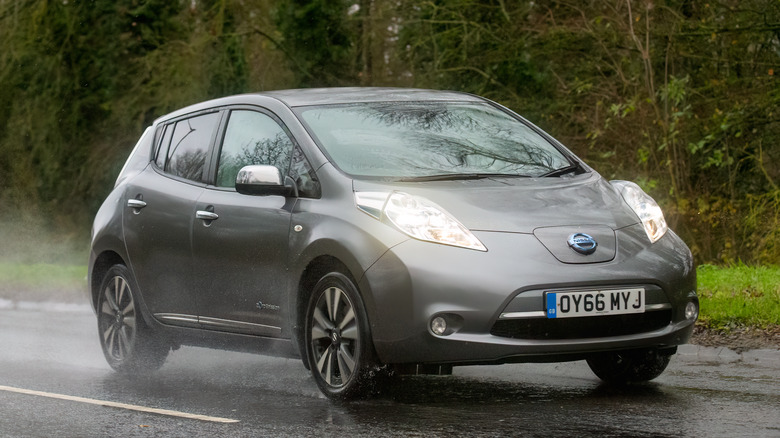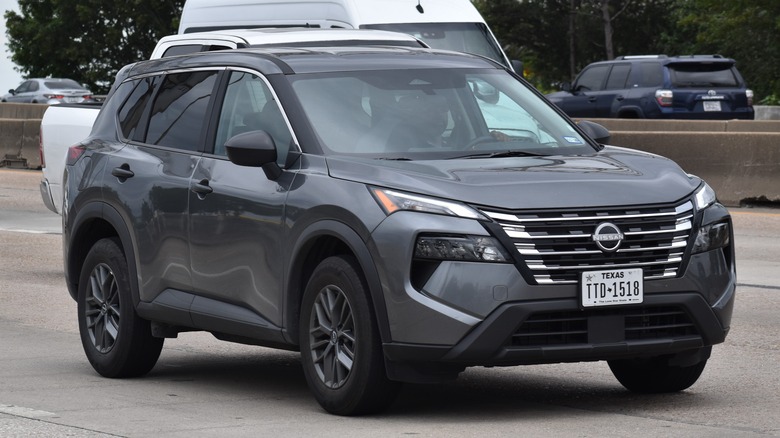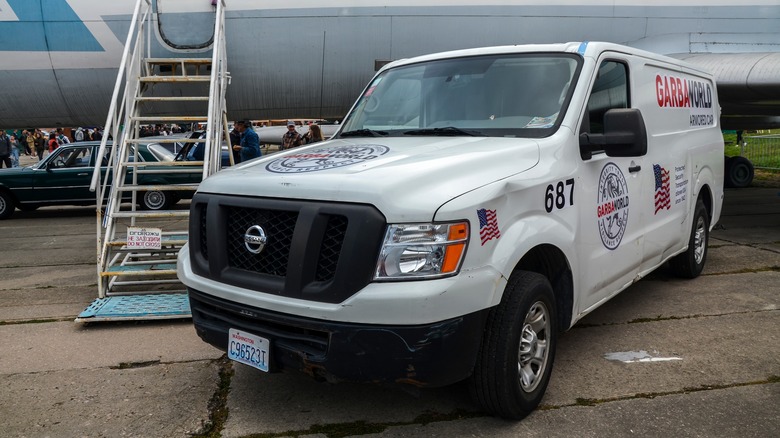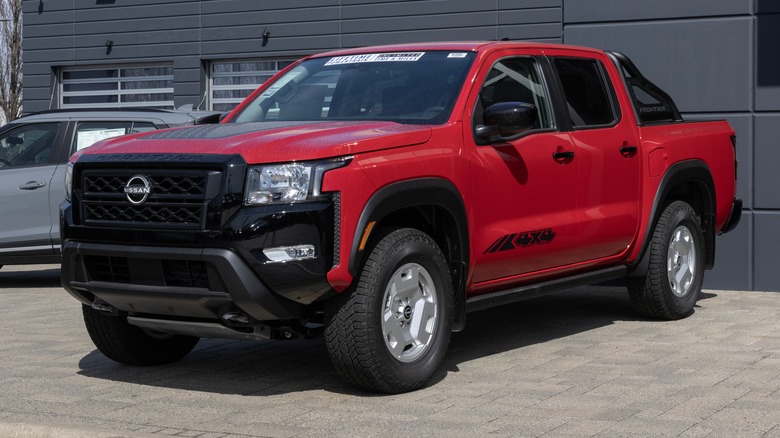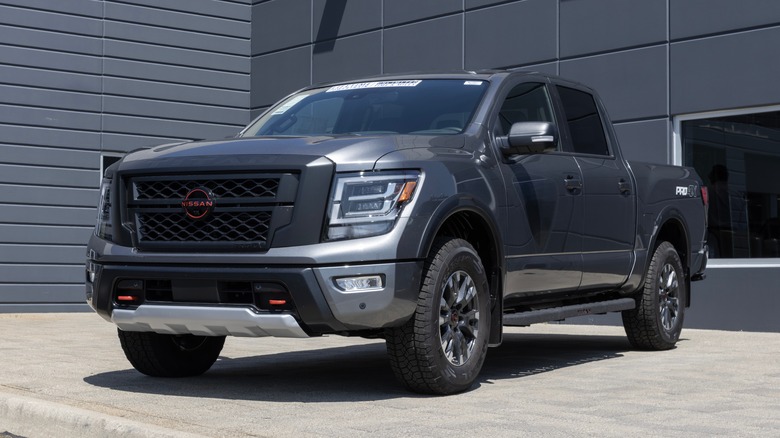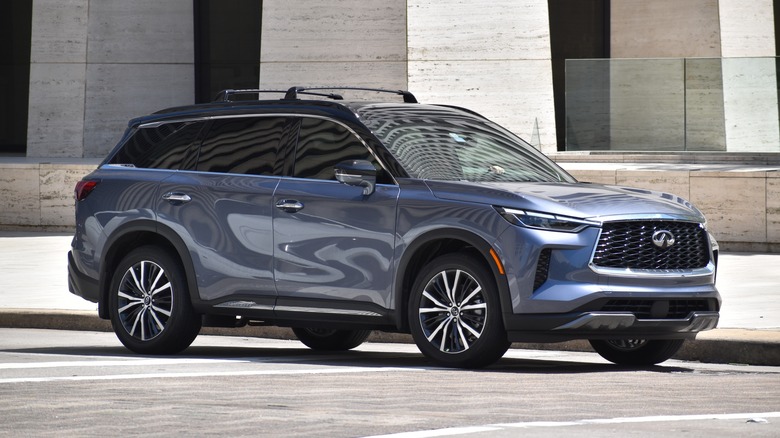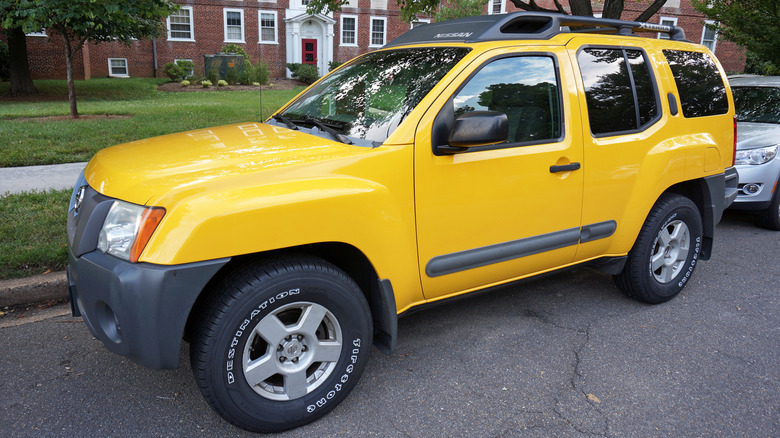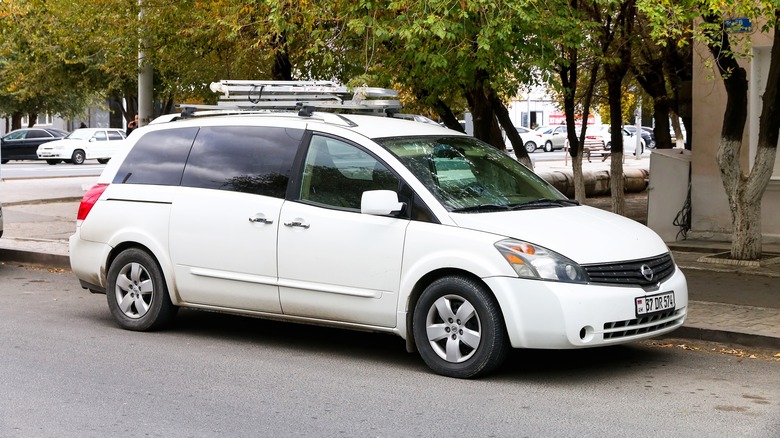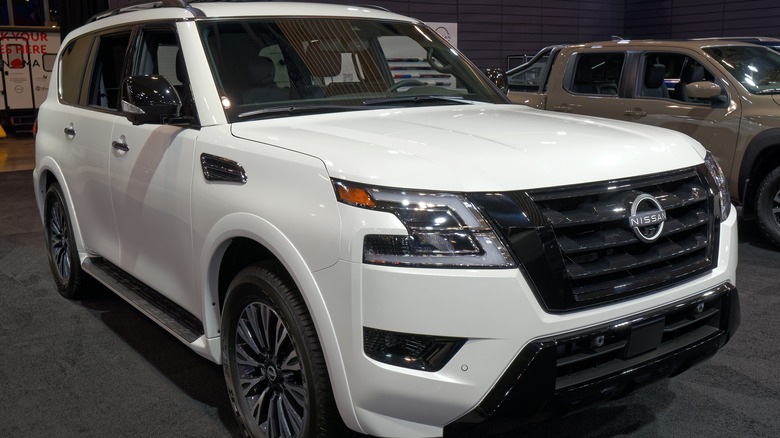Every Nissan Model Made In The U.S.A
Nissan's earliest cars were made in Japan, starting in 1935 at its flagship headquarters in Yokohama. It also started building cars in Mexico in 1966. Almost two decades later, Nissan set up shop for car manufacturing in the U.S. in 1983, opening its first American factory in Smyrna, Tennessee.
Over the years, Nissan's U.S. operations have expanded to include an engine plant in Decherd, Tennessee, and a vehicle plant in Canton, Mississippi. In total, Nissan has invested $14 billion in U.S. manufacturing since 1983. It has proudly built over 19 million vehicles, 18 million engines, and electric motors in the U.S. with help from its 15,000 employees across the different factories.
So, how can you tell if a Nissan was made here in the U.S.? There are a couple of easy ways to check. The Vehicle Identification Number or VIN gives some clues — numbers starting with 1, 4, or 5 mean it was built stateside. The third number or letter identifies the type of vehicle, such as car, truck, etc. And the 10th character shows the model year. You can also take a peek at the inner driver's side door jamb — it'll have a label with the exact place where it was manufactured.
So, what models are actually built by Nissan in the U.S.?
Altima
As a continuation of the Nissan Bluebird line that began in 1955, the first Altima models rolled off the assembly line at Nissan's Smyrna, Tennessee plant in June 1992. Since then, the Smyrna plant alone has manufactured over 4.6 million Altima vehicles. To keep up with skyrocketing demand, a second plant in Canton, Mississippi, entered Altima production in June 2004. This partnership between the Smyrna and Canton plants ensured Nissan could fully meet the needs of the North American market.
For the sixth generation of Altima debuting in 2019, Nissan invested heavily in preparing its U.S. manufacturing facilities for the new model year. A staggering $170 million was pumped into upgrades at both the Smyrna and Canton plants. In the body shop, a new laser brazing system increased precision. A state-of-the-art polyurethane stone guard coat system was also added to the paint shop. Calibration equipment also arrived to help perfect Nissan's ProPILOT Assist technology, one of the top driver assistance systems available.
By August 2018, production of the redesigned 2019 Altima was in full swing across Tennessee and Mississippi.
Murano
The Nissan Murano was introduced back in 2002 as Nissan's first entry into the mid-size crossover SUV segment. Unveiled at the New York Auto Show that year, it soon went into production at Nissan's plant in Kyushu, Japan. As Nissan's first crossover was designed specifically for the U.S. and Canada, the Murano was stylized by Nissan's American studio in La Jolla, California, and was built on the Nissan FF-L platform shared with the third-generation Altima. A few years later, in 2004, the Murano also became available for European buyers.
It wasn't until November 2014 that Nissan really started making the Murano in the U.S. That's when its plant in Canton, Mississippi, became the main place to build Muranos for global sales, bringing over 1,300 new jobs to the facility. Later that year, after production had taken off, Nissan unveiled a refreshed 2015 Murano model at the Los Angeles Auto Show. It had Nissan's newest grille and signature headlight design that really stood out, along with handy new tech like blind spot monitoring, moving object detection, and smart cruise control, which came along for safer driving.
However, since 2020, Nissan has been building the Murano at its Smyrna Assembly Plant in Tennessee instead of Canton, Mississippi.
Rogue
Nissan has had a pretty cool history with the Rogue over the years. It was first introduced as a compact SUV back in 2007 at the Detroit Auto Show. Then, in 2013, introducing its second generation, Nissan gave the Rogue a makeover at its plant in Smyrna, Tennessee (the first time it was manufacturing it in the U.S.), adding some nice upgrades like extra seats, a four-wheel independent suspension, and electric steering. The Rogue turned out to be a real hit for Nissan, too. By 2020, it had made over 14 million vehicles at the Smyrna plant, and almost 1.1 million of them were Rogues. However, now it looks like the future of Rogue production in the U.S. is up in the air. According to a report by CarScoops, Nissan might move to build the next Rogue model from Tennessee to Japan in 2024 instead. During a meeting with parts suppliers, Nissan asked them to cut prices by 20-30% to really lower costs.
If the suppliers can't meet those big savings, Nissan says it won't have a choice but to make the Rogue elsewhere — like in Japan — where it says it can build it around 20% cheaper. Losing the Rogue would be a major blow to the Smyrna plant since it currently makes around 40% of the plant's total yearly output. It could really undermine how important the Rogue has been to Smyrna's success over the last decade.
Maxima
The Nissan Maxima has had one heck of a long run over the past four decades, spanning eight generations. Back in 1976, the Maxima started as an upscale version of the mid-size Bluebird model. However, four years later, it quickly became its own stand-alone nameplate as a full-size car. Production first started up in the U.S. in 2003 for the 2004 Maxima at Nissan's factory in Smyrna, Tennessee. Before then, the model had only been manufactured in Oppama, Japan.
However, two decades later, Maxima production ended in mid-2023. While this spells the end for the gas-powered Maxima, there are hints that the iconic Maxima name may live on in an all-new electric sedan debuting around 2025. It will be built alongside an Infiniti model at Nissan's plant in Mississippi. This move is all part of Nissan's bigger focus on electrifying more of its cars. By 2030, it plans to introduce no fewer than 23 electrified models, with 15 being fully electric.
LEAF
Unveiled on August 1, 2009, the Nissan LEAF had the distinction of being the world's first mass-produced fully electric vehicle. The first-generation LEAF hit the U.S. market between 2010 and 2017 and was initially built at Nissan's plant in Oppama, Japan. However, in 2013, the production of the LEAF started in Nissan's Smyrna, Tennessee factory. Even earlier than that, lithium-ion battery assembly for the LEAF began at the Smyrna plant in 2012, thanks to some federal loans, with the capacity to crank out up to 200,000 batteries yearly.
The Nissan LEAF blazed a trail as the best-selling electric car worldwide, surpassing 400,000 sales by March 2019. By 2020, over half a million Leafs had found homes globally. However, according to CarandDriver, Nissan has announced plans to replace the pioneering LEAF in mid-2020 with a more cutting-edge successor. This means that 2024 will likely be the last full year of availability for the original model. The new Leaf is expected to start rolling out of Nissan's Sunderland, U.K. factory from 2026 onwards.
The Nissan LEAF, aside from being one of the most impressive electric cars of all time (as of 2022), is also one of the most affordable electric cars (as of 2023).
Pathfinder
The Nissan Pathfinder has come a long way since its debut over 35 years ago. Introduced in 1986 as a scrappy two-door SUV, the Pathfinder helped pave the way for Nissan's dominance in the family crossover segment. While originally just a barebones body-on-frame rig, each new Pathfinder model has refined the formula. The first few generations kept it simple as Nissan found its footing. But by the mid-2000s, the Pathfinder had moved to a comfy crossover platform built for both roads and payload. Over one million Pathfinders have rolled off the assembly line at Nissan's Tennessee plant since 2005. Under the hood, a durable engine is precisely crafted at the adjoining Decherd powertrain facility, which also supplies around one million engines annually to other Nissan vehicles produced in the U.S. Now in its fifth generation, the 2024 Pathfinder — codenamed "Rock Creek" — shows how far both Nissan and the Pathfinder name have evolved.
However, even this mighty SUV isn't immune to broader economic challenges. A recent Car Scoops report revealed Nissan's plan to temporarily scale back Q1 2024 production across several nameplates, including the Pathfinder. The goal is to avoid dealer lots getting clogged with unsold vehicles as demand fluctuates. The estimated 1.7% U.S. production dip should be short-lived as Nissan navigates changing consumer tastes and macroeconomic conditions. With nearly four decades of refinement, there's no doubt the Pathfinder name will continue evolving to match the times.
NV
Nissan first started producing its large NV vans — the Cargo and Passenger models — at its plant in Canton, Mississippi, back in 2010. This was actually the only place in the world where Nissan manufactured these workhorses. The NV Cargo, designed for cargo transport, offers a spacious interior for hauling goods, while the NV Passenger, with seats for up to 12 people, is perfect for shuttling groups around.
While Nissan hadn't previously touched the full-size van segment in the U.S. and Canada, the NV series helped them enter that market. The NV Cargo vans — including the NV1500, NV2500 HD, and NV3500 HD models — used the same F-Alpha underpinnings as Nissan's Titan and Armada trucks. However, because these vans needed a completely flat loading floor, Nissan had to modify the design heavily.
Unfortunately, in 2020, Nissan announced that it would stop producing the NV vans and its smaller NV200 commercial vehicles in the summer of 2021 in both the U.S. and Canada. This difficult decision was part of the company's new Business Advantage program, where it hoped to attract more commercial customers with discounts and benefits on its refreshed lineup. It brought an end to over a decade of Nissan vans rolling off the Mississippi assembly line.
Frontier
The Nissan Frontier has been trucking along since 1998, when it was first manufactured in Nissan's Smyrna, Tennessee plant. This kicked off the story of the Frontier nameplate, which dates back almost 40 years as the original compact pickup truck in North America. The first-year model of the first-generation Frontier really stood out with its modern look on the outside and spacious interiors that made it feel more like a car ride. It was bigger and wider than previous models while keeping all the ruggedness, durability, reliability, comfort, and safety you expect from a Nissan truck.
In 2012, Nissan made some big changes to how it produced vehicles between two of its U.S. factories and moved the Frontier's production from Smyrna to Nissan's Canton, Mississippi factory. As a result, Smyrna became an all-unibody production facility, producing the new 2013 Nissan Pathfinder, best-selling Altima sedan, high-end Maxima, all-electric Leaf, and hot-selling Rogue compact crossover. Meanwhile, Canton became Nissan's center of expertise for trucks, where, in addition to the Frontier, it made full-size NV vans alongside trucks and SUVs. The significantly upgraded 2022 model came from there, too.
Titan
The Nissan Titan has called Nissan's Canton, Mississippi, assembly plant home since its big debut back in 2003. Even though the gearbox came from Japan, all the engines were proudly manufactured in the U.S. — the diesel from Columbus, Indiana, and the gas engine from Tennessee. This made the Titan Nissan's first stab at the highly competitive full-size pickup segment. Then, in 2017, it gave the Titan an overhaul and introduced the Titan XD too, which was meant to be the middle ground between light and heavy-duty trucks.
Unfortunately, it looks like 2024 will be the Titan's swan song, as Nissan has confirmed that's when production of the Titan and XD will wrap up this coming summer. It's really no surprise, given its dismal sales over the years. Nissan was hoping to seriously challenge the big dogs like Ford's F-Series, but the Titan never really clicked with buyers. In 2023, it only shifted around 19,189 — less than 3% of the Fords sold in the same 12 months. And that was actually an improvement over 2022 when Titan sales were even lower at just 15,063. It's clear the Titan lineup just never filled a niche or gave truck owners what they really wanted. A real shame to see Nissan's truck dreams grind to a halt after over a decade.
INFINITI QX60
The INFINITI QX60 is a Nissan-owned mid-sized luxury SUV meant to redefine Infiniti's image. Production began in 2012 at Nissan's Tennessee plant, where it was first known as the JX35. Back then, Infiniti realized its naming scheme — like the JX35 — needed an update, as using letters and numbers was getting limiting. The numbers denoted engine sizes, but with turbochargers and hybrids, Infiniti was making smaller engines even more powerful. There was a risk that smaller numbers in future names might give the wrong impression, like the car wasn't performing as expected.
So, in 2014, Infiniti introduced a new naming structure. It got rid of the letter-number combination and replaced it with alphanumeric names without engine size references. This new flexible approach allowed Infiniti more branding freedom globally as a luxury brand. The QX60's new alphanumeric naming scheme had another key benefit — it ensured consistency globally. Whether in the U.S., Japan, or any of Infiniti's 50 markets, a QX60 is instantly recognizable.
Now, over a decade later, the redesigned 2024 Infiniti QX60 Autograph luxury SUV has made its mark. Building on its predecessor's refined image, the Autograph differentiates itself further from multi-purpose family vehicles like the Nissan Pathfinder.
Xterra
The Nissan Xterra was a compact SUV produced from 1999 to 2015 in the U.S. Production started at Nissan's plant in Smyrna, Tennessee, but it eventually moved to Canton, Mississippi, in 2012. When it first launched in 2000, Nissan expected to sell around 60,000 Xterras per year. But demand far exceeded what it planned for — in fact, it ended up shipping nearly 85,000 that year, which maxed out the Smyrna factory's capacity.
After over 15 years on the road, the Xterra was discontinued in 2015. It wasn't just that it only got one major redesign back in 2005; consumer wants had simply shifted. Its on-road manners were nothing special, and while its lifted ride height was cool at first, people got used to crossovers that feel more stable when cornering. Its 4.0-liter V6 engine also felt outdated compared to competitors' smaller turbo engines, packing more pep.
Interestingly, the Nissan Xterra was based on the Nissan Frontier pickup, so they shared many parts, which helped streamline production. Nissan was already building the frame and components used in the 2015 Xterra for the Frontier and the full-size Titan truck.
Quest
The Nissan Quest has been a popular minivan choice since hitting the roads in 1993. Over its four generations and about 25 years of production, the Quest offered families easy cargo space and seating for up to eight.
The first-generation 1993-1998 Quest — also called the V40 — was a joint project between Nissan and Ford. This first-gen model rolled off the assembly line at Ford's Ohio plant alongside its twin, the Mercury Villager. While similar under the skin, the Quest established itself with Nissan's value and reliability.
In 2004, Nissan expanded and took over full production of the Quest, moving it to the Canton, Mississippi plant. By the 2011 redesign, Nissan adopted a widened version of its worldwide Elgrand as the new Quest. This fourth-gen model came straight from Nissan's plant in Kyushu, Japan, where the automaker's minivan expertise truly shone.
Once a popular choice for families, sales of the Nissan Quest started to decline in the U.S. market as more consumers turned to crossovers. Even in the Quest's heyday, it only accounted for around 3% of America's shrinking minivan pie. By 2017, Nissan decided to officially pull the plug on the Quest in the U.S. market. Safety reviews also played a role in the discontinuation. 2011-2017 Quests earned Poor ratings in front crash tests from the IIHS, while roof strength received an Acceptable score.
Armada
The hulking Nissan Armada has always been an American-sized SUV at heart. Originally launched in 2003, the first-gen Armada was built in the States at the Canton, Mississippi factory on the same underpinnings as the Nissan Titan pickup truck.
Fast-forward to 2017, and the Armada entered its second generation with a redesign that brought it more in line with its luxury brother, the Infiniti QX80. Both now use the rugged Patrol platform from Nissan, which also meant the Armada packed more power under the hood thanks to an upgraded V8. However, production was moved across the Pacific to Kyushu, Japan, in 2016. This helped free up space at the Canton plant to ramp up making the all-new Nissan Titan truck.
Despite now being built abroad, American buyers have stayed loyal to the Armada over the years. The 2024 model continues living up to its nameplate as one seriously mammoth SUV. It comfortably seats up to eight and, being one of the best SUVs for towing, can hurl a whopping 8,500 pounds, making it a great all-purpose family hauler no matter what your transport needs. With its no-nonsense build and room for everyone plus their stuff, the Armada keeps on proving why it remains a popular choice in the U.S.
